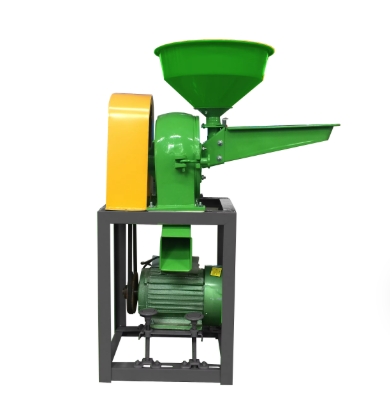Molendina Oryzae Tradionalia versus Moderna
Molis Lapidum et Hullers Manuales
Molae lapidum habent etiam historiam in mundo tradicionalis molitionis oryzae. Hae aequentes erant rudimentaria per saecula, cum vi humana constans multarum molitionem oryzae. Haec actio fit cum mola lapidea quae conterit cuticulam et amputat glumam (stratum exterius), praebens oryzam politam. Figura 1 Etiam quamvis traditionale, hoc genus operationis est nimis tardum et etiam inefficax in aliqua mensura, praesertim in exitu. Hullers manu operati sunt etiam necessarii in cultura oryzae parva scala. Hi permittere agricolis ut decorticent cuticulam oryzae manu et sunt essentialis pro villis qui non habent accessum ad machinamenta moderna. Tamen, methodi traditionales descriptae supra habent inconvenientia tales qualis efficacia bassa, requirmentum laboris altum, quod deprimunt efficaciam productionis et possunt affectare uniformitatem qualitatis oryzae.
Innovationes in Tecnologia Rotularum Ferratarum
Frictio oryzae cum volventibus ferreis est magnus progressus in molitione oryzae; eliminat necessitatem veterum methodorum fricationis lapidea et manualis. Volventes ferrei operantur etiam soli - in clara contrarietate ad priores formas, quae magis viro manus requirebant - addentes stratificatum efficientiae ad laborem decorticandi et albedinis. Hoc instrumentum transformavit drasticam molitionem oryzae, accelerans operationes batch et minuens manum operationem, dum effectualiter incrementum producit. Introducere machinamenta molae oryzae in industria batch oryzae est modus partialis operationis automatizatae, qui ab multis industriis oryzae adhibetur ut minus oneris sit in labore manu factum. Technologia moderna, quae iuvat meliorem qualitatem oryzae praebere, minuit plus aleae et impuritates, quod meliorem qualitatem consequitur. Molae, quae in hos novos processus investiunt, uniformem qualitatem securus erunt et fortasse maius redditum, quia minores amittunt translationes molitionis, quae meliores optiones praebent consumptoribus, qui meliorem oryzam desiderant.
Nucleares Species Machinarum Molitionis Oryzae
Molis Oryzae Unicus-Lapsus
Molis oryzae ad usum unius transitus praebent formam optime aptam manipulationi frumenti in molitionem oryzae recentis, quocumque tempore. Haec machina possunt decorticare et albidare oryzam uno tantum processu, idonea firmiter pro firmis mediocribus vel parvis. Praecipue utiles sunt his, qui quaerunt novas vias accelerandi molitionem absque addendo instrumenta nova aut cara. Successus eorum in tractatu oryzae potest fundari in datum industriae indicante molis ad usum unius transitus magnum officium praebebant in efficientia producendi oryzam, cum magnis gradibus productionis. Exempli gratia, opportuna sunt agris parvis, qui volunt augere exitum suum sine multo investimento in technologiam.
Systemata Multiplici-Lapsu Processei Oryzae
Systema molendinum multistadii sumit viam alternativam, quae complures stadia molendi complectitur, scilicet purgationem, decorticamentum, albedinem, polituram et classificationem. Hi processus sunt qualitate et reddito ducti et magis congruunt cum efficientia materiarum primarum in comparatione ad praecessorem suum unius transitus. Tales systemata utuntur in regionibus aut industriis quae specialiter in productione hordei altioris valoris in magnis quantitatibus versantur. Systema eorum processuum gradatim securit ut hordeus habeat finitionem eximiam et idoneum est pro produceribus qui volunt bonum hordeum conficere. Operationes grandis scalae, sicut illae in regionibus magna consumtione hordei (Asie orientali, exempli gratia), item communiter systemata plurium transituum utuntur.
Solutiones Moliendae Compactae et Mini
Compacta et minima solutio molendini facta est popularissima electio pro agricolis parvis et mediocribus, et facile potest elaborari costus machinarum molendarum minimarum. Hae machinae sunt perfecta congruentia pro agricolis oryzae qui non possunt iustificare impensam carissimam. Scopus talium instrumentorum est minimizare spatium terrae necessarium, dum tamen praebet bonam qualitatem systematis molendini. Historiae successus Agricolae qui adoptaverunt solutiones istas condividunt testimonia quae depingunt imaginem melioris productivitatis et lucris, quamvis adhuc in scala multo minore sint. Agricolae, praecipue in nationibus inchoantibus, saepe adoptant tales systemata parva ad meliorem molendinum oryzae sine magnis investmentis. Systemata huiusmodi facultatem conferunt minoribus structuris ut competant cum maioribus participantibus per bonum usum faciendum de suis resource.
Molae Oryzae Commercialis et Industrialis
Systemata Automata Magna Capacidadine
Automatio altae productivitatis revolutionizavit processum industrialis oryzae ad permitiendum operationes gravis in amplitudinem absque multo labore manu. Huiusmodi systemata comprehendunt instrumenta sapientia, sensa et software ita ut administratio hospitalitatis efficiat se magis et magis efficientem. Sensa praebent statum molitionis pro solatio et clara molitura necnon etiam deprehensionem conditionum intolerabilium, et software ducta molitura phasica adiuvant analysin datarum processualium praebentes solutionem simplicem ad meliora molitionis. Super biennium praeteritum, fuit incrementum notabile adoptionis harum operamentorum automatarum per mercatum verticales. Hoc incrementum venit in responsum ad crescentem petitionem consumatoris pro oryzae optima qualitate. Sunt parva systemata parandi paddy economia laboris disponibilia, sed non solum auctam productivitatem praebent sed etiam meliorem qualitatem totius oryzae processatae.
Instrumenta Specialia pro Controllo Qualitatis
Qualitas controlis in molendinis oryzae praecipuum officium in certamine exhibet. Et machinae diversae speciales adhibentur ad purgandam vel gradum oryzae constituendum, ut normas necessarias consequantur. Idem ad sortitionis machinas pertinet, quae frumenta secundum magnitudinem et colorem separant, et machinas gradandas, quae oryzae secundum qualitatem parametrorum, sicut longitudo et nitens, dividunt. Praeterea, instrumenta probationis productuum tutelam et qualitatem nutritionis confirmant. Si faber non graviter de qualitate controlis cogitat, hoc paene in malis productis resultabit, quae nomen et fiduciam consumptoris laedunt. Proinde, investitio in systema QA dedicatum essentialis est ad capiendum et tuendum locum firmum in mercato et ad confirmandum quod oryza fabricata sit ut consumptor exspectat.
Considerationes Principales Cum Molam Oryzae Eligis
Capacitas Productionis et Efficientia
Est necessarium productionem capacitatis lineae molendinae oryzae, quam elegisti, considerare, quia una ex factoribus est, quae tibi iuuant ad praestantiam in mercato consequendam. Optime molendinum oryzae tuum debet accommodari necessitatibus molitionis et processus mercati localis, minima spolia et maxima efficientia procurando. Exempli gratia, in molendinis oryzae, systemata automata magnae capacitatis, qualia in Côte d'Ivoire utuntur, possunt unam tonnam per horam minimo processare, quod magnum auxilium in productione oryzae latiore scala praebet. Per analysin efficientiae aliorum operationum super exitu per horam et scala, istae mensurae sunt importantissimae non solum ultra capacitatem, sed intra eam. Molendina cum technologia moderna optimos effectus molitionis generant et nimium spolium prohibent. Duces industriae solent regulas circa istas metricas constituere, quae eas utilis reddunt novitati tam ad successum proprium comparandum quam ad investigandum ubi locus est ad melius.
Consumptio Energiae et Necessitates Conservandarum
Magnus consumptio energae in industria frumenti oryzae 375-625 therm/ton fecit hanc sectorem sensitivam in consumptione energiae inter industrias agro-basatas. Quando eligis molendinum quod est ad modum parvam consumptionem energiae descriptum, reducis expensas tuas et colis rationem magis sustinibilem negotii gerendi. Praeterea, requisita conservationis sunt factor importantis pro longa supervenienda molendini. Etiam si altus est costus conservationis, applicatio eius regulariter potest garantire optimam operationem instrumentorum et vitare tempus carum non operandi. In hoc iuvando, industria conversa est ad measuras sustinibilitatis quae ponunt accentum in minuendo vestigio energie et promovendo usum responsabilem resourcearum. Utraque contribuunt ad minuendum expensas et meliorem faciendum valorem molendini in mercato et congruentes actiones suas ad directivam globalis sustinibilitatis.
FAQ
Quae sunt differentiae principales inter molae oryzae traditionales et modernas?
Molis oryzae traditionales multum manu operantur et simplicioribus machinis utuntur, sicut molibus lapideis et decorticatoribus manualibus, quae possunt esse laboriosa et inefficaces. Molis oryzae modernae technologias aversas utuntur, sicut systemata volubilia ferrea et automationem ad efficaciam, qualitatem productionis et exitum meliorem promovendum.
Quomodo technologia volubilium ferreorum meliorem facit molitionem oryzae?
Technologia volubilium ferreorum automatisat processus decorticandi et albandi, efficaciam productionis magnopere augens per amotionem maioris paleae et immunditiarum, ita producendo productum maiore qualitate cum minori labore manuarii.
Quae factores considerari debent quando molam oryzae eligis?
Factores principes includunt capacitem productionis, efficaciam, consumptionem energiae et necessitates conservationis. Cura ut molae congruat cum magnitudine mercati et normis sustinibilitatis est crucialis pro optimo costibus et competitivitate.

